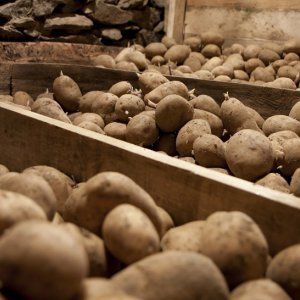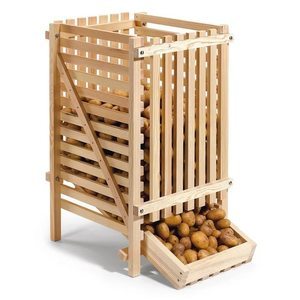Rules for storing potatoes in the cellar
In their own home and even sometimes in the city, potatoes are stored in a cellar - a separate dry room with constant temperature and humidity, where you can create better conditions. However, there are nuances even in such a simple matter as storing vegetables in the cellar: is all potatoes suitable for such storage, how exactly to decompose them, what should be the air parameters? So, let's figure out how to properly store potatoes in the cellar in winter.
The content of the article
- What varieties of potatoes are suitable for long-term storage
- When to put potatoes in the cellar
- How to prepare a cellar
- Tuber preparation
- Storage methods in the cellar
- Temperature and humidity requirements
- How to protect against moisture and freezing
- How to store seed tubers in the cellar
- The most common mistakes
- Conclusion
What varieties of potatoes are suitable for long-term storage
Before putting potatoes in the cellar for a long time storage, make sure you have the right variety for this. Not every variety is suitable for many months of maintenance without processing.
Pay attention to these criteria:
- The main enemy of long-term storage is moisture, therefore, the more dry matter in the tubers, the longer they are stored. Thus, the first selection criterion long-lasting variety - high starch content.
- Potatoes are laid for storage in the fall after the final harvest. Therefore, the later the potatoes ripen, the longer they are stored. The second criterion is whether the variety belongs to mid- or late-ripening.
- The third criterion is disease resistance. Such a common potato disease as late blight can destroy half of the crop, even if the conditions are right in the cellar. Slightly reduces the likelihood of infection by pre-harvesting from the tops bed before digging potatoes.
Due to the climatic conditions in Russia, late varieties of potatoes are more often grown in the southern regions. There he manages to safely pass the entire growing season - 110-140 days.
So, according to the listed criteria, several varieties can be distinguished that are especially well tolerated for long-term storage in the cellar. These include:
- Bronnitsky. Bred in the late 80s of the 20th century in the Leningrad region. Disease resistant, yet delicious. This mid-ripening variety forms large tubers with a light yellow skin. The keeping quality of the variety is estimated at 95%.
- Blue. It is a late-ripening variety with yellow-skinned tubers with white flesh. Developed in the 90s of the 20th century for the Central Black Earth regions and regions in the Volga water area. Keeping quality is 90-95%.
- Zhuravinka. The mid-late variety was bred in Belarus, widespread in Russia. Very productive, resistant to weather changes, not afraid of most nightshade diseases. The tubers are red, the flesh is light yellow.
- Lorkh. It is grown in the central part of Russia and in the south. The tubers are yellow, ripen 120-140 days after planting (late ripening). Contains a lot of starch.
- Gull. This fruitful variety is acclimatized for the north-western regions of our country, however, it is late ripening. Light yellow tubers with creamy flesh. Keeping quality is 92%.
When organizing storage, it is also important how the potatoes were grown:
- It is also important how rainy the summer was. If it was very wet, then the tubers will contain a lot of moisture and will be much worse stored.

- Potatoes grow best on light, non-clay soil mixed with sand.A vegetable grown on peat or black soil is unlikely to last until spring intact.
- Potatoes grown with the use of a large amount of fertilizers, in particular, nitrogenous, do not tolerate long-term maintenance in the cellar. Too much nitrogen leads to the deposition of sugars in the tubers and increases the likelihood of infection with diseases and pests. Fertilized potatoes are easy to spot - they have a thin skin and a watery core. At the same time, when growing, it is important to provide the plant with a sufficient amount of potassium in the soil. If this substance is not enough, potatoes will also be poorly stored.
- The early harvest will also be bad. The skin of such a vegetable is too thin to provide protection from damage and disease.
When to put potatoes in the cellar
Since each of these varieties has its own ripening period, the period for harvesting in the cellar is also different for them. In addition, you need to prepare a storage room and the tubers themselves.
How to prepare a cellar
The optimum constant temperature is 2-4 ° C. Constant humidity - 80-90% - is also extremely important - as well as protection against water ingress.
Attention! Since the tubers "breathe" and emit carbon dioxide, the room must be ventilated.
The cleanliness of the cellar is of great importance, therefore it is pre-treated.
Treatment
All unnecessary things are thrown out of the cellar, garbage is removed, the floor is swept. Shelves that will be stored boxes with potatoes, brought out in the sun and dried. Then they are treated with antifungal drugs. The walls and ceiling are inspected for mouse and rat passages; if there are any, they are filled with cement. After that, the walls and ceiling are treated with lime.
After all these actions, the cellar is left open to dry it for 3-4 days.
Preparing the storage container
If potatoes are stored in wooden crates or pallets, they are inspected for damage, replaced with new ones if necessary. Then the boxes are cleaned of soil and other contaminants and washed with soapy water. After that, they are dried in the sun.
Tuber preparation
After harvesting from the field, the tubers should, first, be dried. This is done to remove excess moisture and reduce morbidity. At first, the harvested tubers are dried directly in the garden for about two hours. Then they are laid out in a cool room (about + 15 ° C) and left there for two weeks - during this time the peel hardens.
Then the potatoes are cooled, gradually (every two days) reducing the temperature in the room by 1 ° C. The final temperature must be + 1 ° C.
Storage methods in the cellar
So, the potato tubers and the room are prepared for long-term storage, it is time to choose in what form they will be in the cellar. There are several options: store vegetables in boxes, in bags, in nets, in closed containers, or simply in bulk. Let's look at each storage method.
In wooden boxes

Convenient and correct when storage boxes for potatoes are on racks or pallets. Two drawers are placed on the shelving shelf, they are not placed close to each other, but keeping a certain distance: 5 cm between the drawers and 3 cm from the wall.
A coniferous tree is more suitable for boxes, the distance between the slats is about 4 cm.
In bags made of natural fabric
Most often, potatoes are stored in canvas bags. This method allows the tubers to breathe, not overcooling and not getting wet. There should be a distance of 5-10 cm between the bags. The bags are also placed on pallets.
In bulk
You can store potatoes simply by sprinkling them on pallets. But in this case, rotting of the fruit is possible due to poor air exchange.
In grids
Often, potato tubers are stored in nets, which are again stacked on pallets. However, in this case, the nets with potatoes must be covered with a layer of straw or old jackets on top so that the tubers do not freeze.
Temperature and humidity requirements
At what temperature should the cellar with potatoes be closed for the winter? The optimum temperature is from +2 to + 5 ° C and humidity is not higher than 95%.
How to protect against moisture and freezing
Enemies of long-term storage of vegetables are excessive moisture and cold... What can be done to protect potatoes from dampness? On top of it, you can lay beets, which will absorb excess moisture. Maintaining a constant temperature in the cellar, as well as thermal insulation of the room itself, will save you from the cold.
How to store seed tubers in the cellar
In order for seed potatoes to retain all their qualities, before laying them in the cellar, they are not only dried, but also planted, that is, they are left in the open air for a week. This treatment increases the resistance of the tubers to disease. After planting, the tubers are sorted out, the damaged and sick ones are thrown away.
Potatoes shelf life
Subject to all the rules, potatoes can be stored in the cellar until the next harvest. But usually by the beginning of the summer season, the potatoes in the cellar are over.
Attention! Late ripening varieties begin to emerge from dormancy around March.
The most common mistakes
Despite the correct selection of varieties for storage, harvesting under suitable conditions and a cellar equipped according to all the rules, vegetables may still not last until spring and deteriorate.
This happens for several reasons:
- Storage temperature drop too quickly. If you lower the temperature in the cellar too quickly, the starch in the potato quickly decomposes to sugar, the tuber is damaged, and the potato rots.
- Too rare sorting of tubers. During the entire storage period, it is necessary to periodically inspect the vegetables laid in the cellar and remove rotten or diseased ones. If this is not done, by the spring it may turn out that the harvest is half-lost.
- Storage temperature too low. In this case, the potato freezes, which affects its taste and keeping quality.
- Germination of tubers. So that in the spring, when the outside temperature rises, the potatoes do not germinate, the temperature in the cellar is lowered by 1 ° C, and the tubers again fall into a state of forced dormancy.
Conclusion
It is convenient to store potatoes in the cellar in winter, but it is important to know how to do it correctly. In order for the tubers to lie for a long time, they are pre-dried, and the cellar is cleaned and treated with antifungal drugs and lime.
Not all varieties are suitable for long-term storage; late-ripening potatoes are the best keeping quality. In addition, it matters how and where it was grown and how it was harvested.